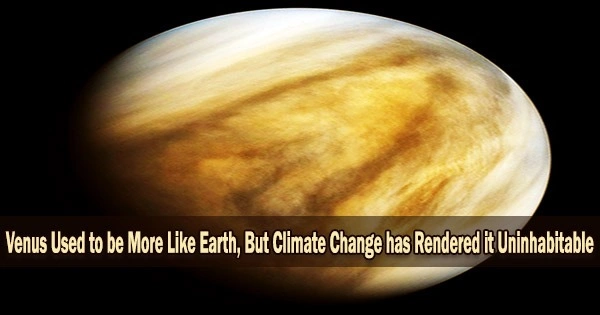Venus, our sister planet, has a lot to teach us about climate change. Venus currently has a surface temperature of 450°C (the temperature of an oven’s self-cleaning cycle) and an atmosphere that is 90 times more dense than Earth’s and dominated by carbon dioxide (96%) than any other planet.
Except possibly 60 kilometers up in the clouds, where the new discovery of phosphine may imply floating microbial life, Venus is a very odd and uninhabitable planet. But the surface is totally inhospitable.
However, Venus once likely had an Earth-like climate. Recent climate modeling indicates that Venus had surface temperatures comparable to those of the modern Earth for a large portion of its history. It most likely also had continents, plate tectonics, rain, snow, seas, and, even more speculatively, perhaps even surface life.
A runaway greenhouse effect caused the climate to drastically change less than one billion years ago. The enormous climatic change event that drained the seas and brought about the end of the water cycle may have been produced by an intense episode of volcanism that released sufficient carbon dioxide into the atmosphere.
Evidence of change
This hypothesis from the climate modelers inspired Sara Khawja, a master’s student in my group (co-supervised with geoscientist Claire Samson), to look for evidence in Venusian rocks for this proposed climatic change event.
My Carleton University research team has been mapping and interpreting the geological and tectonic history of Earth’s amazing sister planet since the early 1990s, and more recently, my Siberian colleagues at Tomsk State University.
In the 1970s and 1980s, the Soviet Venera and Vega missions successfully touched down on Venus, taking photos and analyzing the rock composition before the landers were destroyed by the planet’s intense heat and pressure.
However, our most comprehensive view of the surface of Venus has been provided by NASA’s Magellan spacecraft in the early 1990s, which used radar to see through the dense cloud layer and produce detailed images of more than 98 percent of Venus’s surface.
Ancient rocks
The earliest form of rocks on Venus, known as tesserae, have a complex look that suggests a lengthy, complex geological past, which is where our focus in our hunt for geological evidence of the huge climate change event has led. We thought that these oldest rocks had the best chance of preserving evidence of water erosion, which is a such an important process on Earth and should have occurred on Venus prior to the great climate change event.
We attempted to identify historic river valleys using an indirect technique in light of the low resolution altitude data. We proved that the troughs in the edges of tesserae had been filled with fresher lava flows from the nearby volcanic plains.
Our surprise at how closely these tesserae valley patterns resembled river flow patterns on Earth led us to hypothesize that these valleys were created by river erosion during a period of climate similar to that of Earth. My Venus research groups at Carleton and Tomsk State universities are studying the post-tesserae lava flows for any geological evidence of the transition to extremely hot conditions.
Earth analogies
In order to understand how volcanism on Venus could produce such a change in climate, we can look to Earth history for analogs. We can find analogies in super-eruptions like the last eruption at Yellowstone that occurred 630,000 years.
But such volcanism is small compared to large igneous provinces (LIPs) that occur approximately every 20-30 million years. These eruptions have the potential to emit large enough amounts of carbon dioxide to drastically alter Earth’s climate, resulting in major extinctions.
To give you a sense of scale, consider that the smallest LIPs produce enough magma to cover all of Canada to a depth of about 10 meters. The largest known LIP produced enough magma that would have covered an area the size of Canada to a depth of nearly eight kilometers.
The LIP analogs on Venus include individual volcanoes that are up to 500 kilometers across, extensive lava channels that reach up to 7,000 kilometers long, and there are also associated rift systems where the crust is pulling apart up to 10,000 kilometers long.
If LIP-style volcanism was the cause of the great climate change event on Venus, then could similar climate change happen on Earth? We can imagine a scenario many millions of years in the future when multiple LIPs randomly occurring at the same time could cause Earth to have such runaway climate change leading to conditions like present-day Venus.
















